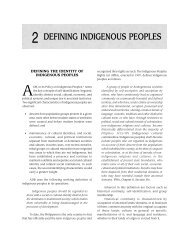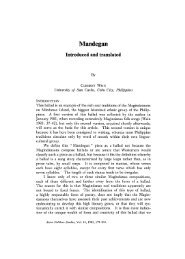1 Seidenadel's Grammar of Bontoc Igorot: One Hundred Years On
1 Seidenadel's Grammar of Bontoc Igorot: One Hundred Years On
1 Seidenadel's Grammar of Bontoc Igorot: One Hundred Years On
- No tags were found...
You also want an ePaper? Increase the reach of your titles
YUMPU automatically turns print PDFs into web optimized ePapers that Google loves.
LAWRENCE A. REID Seidenadel’s <strong>Grammar</strong> <strong>of</strong> <strong>Bontoc</strong> <strong>Igorot</strong>: <strong><strong>On</strong>e</strong> <strong>Hundred</strong> <strong>Years</strong> <strong>On</strong> 10<br />
(16) sak-en nan nangney si nan fótogmo.<br />
[sakʔɨn] PRED<br />
[nan naŋ-ʔɨy ʔas nan ˈfutug=mu] NOM<br />
1SG SPEC PRF.NMLZ-go OBL SPEC pig=GEN.2SG<br />
‘I was the one who took your pig.’ (Lit. ‘The taker <strong>of</strong> your pig was me.’)<br />
(17) iyálim nan fotog an sak-en.<br />
ʔi-ˈʔali=mu [nan ˈfutug] NOM<br />
ʔan sakʔɨn<br />
MFCT-come=GEN.2SG SPEC pig OBL 1SG<br />
‘Bring the pig to me.’<br />
The only forms that SDL considered to be true pronouns were the unmarked forms, noting also<br />
that shortened forms <strong>of</strong> the pronouns were attached as personal agreement suffixes on “personal<br />
verbs”. He considered the unmarked forms to be nominative and was forced to conclude, because<br />
the same form was used for the undergoer <strong>of</strong> a “possessive verb”, that “The form <strong>of</strong> the personal<br />
pronoun for nominative and accusative is alike in <strong>Igorot</strong>” (30). SDL considered the subjects <strong>of</strong> his<br />
“personal verbs” to be in the nominative case, but not the agents <strong>of</strong> his “possessive verbs” (65).<br />
The pronominal endings <strong>of</strong> such verbs were considered to be suffixed agreement markers, not<br />
pronouns (although he likens them to the “pronominal subject <strong>of</strong> our ‘transitive’ verbs” (36). This<br />
analysis was supported by the fact that the forms are in fact phonologically attached to the verb,<br />
and by his view that transitive verbs are not really verbs at all, but nouns, and therefore the<br />
agreement forms were genitive and different from those that appeared on intransitive verbs. SDL’s<br />
analysis suggests that even third person substantives would also be marked on the verb, as, for<br />
example, in Chamorro (TOPPING 1973:106, COOREMAN 1988:565, REID 2002:70), but typically<br />
they are not.<br />
In order to consider the independent, unmarked pronouns as the grammatical subject <strong>of</strong><br />
intransitive verbs, SDL needed to analyze the optional topic linker ya in sentences such as ex. 14<br />
and 15 as a copula, giving a possible SV word order. “If these subjects precede, the copula ya (for<br />
singular and plural and all tenses) is <strong>of</strong>ten placed between the subject and the verb; but never if<br />
the subject follows” (15, 66). He recognized however that personal pronouns in sentences with<br />
this word order were focused, and therefore “[t]he personal pronouns, as subjects <strong>of</strong> verbs, are<br />
only used to emphasize the subject.”<br />
SDL’s view that unmarked pronouns are used for emphasis fitted neatly into his analysis <strong>of</strong> the<br />
difference between the various transitive sentences, in which “accusative” NPs, when pronouns,<br />
were “emphatic”. He states, “Personal pronouns, used only if the subject shall be emphasized,<br />
precede the verb” (66). Similarly, “If emphasized, place, cause, instrument, time, the indirect<br />
object or dative, etc., can be made the subject … <strong>of</strong> peculiar verbal forms” (27). This is little<br />
different from the views <strong>of</strong> Blake and later linguists who considered that the “subject” or<br />
“focused item” functioned to emphasize that NP.<br />
While considering the undergoer <strong>of</strong> a transitive verb to be “accusatively marked”, he<br />
nevertheless clearly recognized that such NPs don’t correspond to the accusative NPs <strong>of</strong> English.<br />
In introducing the verbs that head transitive sentences, he said, “…by employing special verbal<br />
forms the person in whose behalf, for whom an action is performed, or the instrument used in the<br />
action, or the place, time, cause, where, when, why the action takes place, took, will take place,<br />
can be made the “subject” or “object” as we would say” (italics provided) (89). Similarly, in<br />
discussing the position <strong>of</strong> “[the] “subject” and “object” [<strong>of</strong> transitive verbs]”, he notes that “verbs<br />
which we consider customarily [to be] transitive… are <strong>of</strong> a completely different nature in <strong>Bontoc</strong><br />
<strong>Igorot</strong>” (25).<br />
SDL considered what we refer to today as cleft constructions as constructions which emphasize<br />
one <strong>of</strong> the nominals in a sentence, as illustrated in ex. 16. He says, “Thus while some stress is laid<br />
upon the elements treated as “subjects” or objects”, stronger emphasis is expressed by placing the<br />
important substantive or pronoun etc. at the beginning <strong>of</strong> a sentence, followed by nan and the<br />
Nomen actionis” (92). Similarly, “The “Accusative Object” as we should say, is strongly<br />
emphasized by being placed at the beginning <strong>of</strong> a sentence, followed by the Nomen actionis with<br />
its endings” (100).<br />
10

















